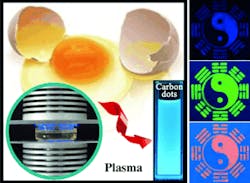Fluorescent carbon dots are synthesized from eggs (yes, eggs)
Nanjing, People's Republic of China--It's easy to imagine them sunny side up or scrambled, but now eggs—yes, chicken eggs—can be used to make fluorescent carbon dots or luminescent printable inks. In a paper published in the journal Angewandte Chemie International Edition, researchers at Nanjing University of Technology have done precisely that; they have used eggs and a plasma pyrolysis process to produce fluorescent carbon dots or luminescent printable inks.1
The researchers say these luminescent carbon nanoparticles have certain advantageous optical properties: they fluoresce. They are also biocompatible, and therefore better suited for imaging procedures in the biosciences than metal-based semiconductor quantum dots. Although a variety of processes have been developed to make these miniature objects known as carbon dots or C-dots, Chinese researchers have now introduced a new method in the journal Angewandte Chemie by which C-dots are produced particularly quickly and inexpensively. In addition, they have demonstrated the use of these luminescent dots as printer ink.
The new process is based on plasma-induced pyrolysis. A plasma--a gas whose components have been partially or completely separated into ions and electrons--is highly reactive and energetic, and its uses include plasma welding, for which it serves as the heat source. A team led by Su Chen at Nanjing University of Technology directed a special plasma beam onto a small amount of egg yolk or egg white in order to carbonize the material. Within a few minutes, they formed C-dots with a yield of about 6%.
The C-dots obtained from the egg yolk have a crystalline structure and a diameter of about 2.2 nm; those from the egg white are amorphous and measure about 3.4 nm. They contain mainly graphitic structures. Oxygen and nitrogen atoms are also bound to the surface in various ways, allowing for good solubility in a broad range of aqueous and organic solvents. The C-dots are not sensitive to acids or bases and under ultraviolet (UV) light, they fluoresce bright blue. It is presumed that the luminescence comes from passivated surface defects that "trap" the excitatory UV light like antennae.
The researchers were able to follow the pyrolytic process by means of thermogravimetric analysis and IR spectroscopy: it includes the uncoiling and breaking down of proteins as well as various chemical reactions. Towards the end, primarily carbon dioxide, ammonia, and water are released. "This process is not limited to eggs," explains Chen, "it works with many inexpensive natural carbon sources, including sugars."
The scientists fabricated inks based on the luminescent C-dots and printed glowing patterns on a variety of surfaces by both inkjet and silk-screen printing processes. The addition of small amounts of organic dyes or semiconducting quantum dots allows the color of the ink to be varied. "Such fluorescent inks may be useful in optoelectronic applications," says Chen, "for example in forgery-proof labeling and optoelectronic sensor applications."
REFERENCE
1. Jing Wang et al., Angewandte Chemie International Edition 51, 37, 9297–9301 (September 10, 2012).
SOURCE: Wiley; www.wiley.com/WileyCDA/PressRelease/pressReleaseId-105099.html

Gail Overton | Senior Editor (2004-2020)
Gail has more than 30 years of engineering, marketing, product management, and editorial experience in the photonics and optical communications industry. Before joining the staff at Laser Focus World in 2004, she held many product management and product marketing roles in the fiber-optics industry, most notably at Hughes (El Segundo, CA), GTE Labs (Waltham, MA), Corning (Corning, NY), Photon Kinetics (Beaverton, OR), and Newport Corporation (Irvine, CA). During her marketing career, Gail published articles in WDM Solutions and Sensors magazine and traveled internationally to conduct product and sales training. Gail received her BS degree in physics, with an emphasis in optics, from San Diego State University in San Diego, CA in May 1986.
